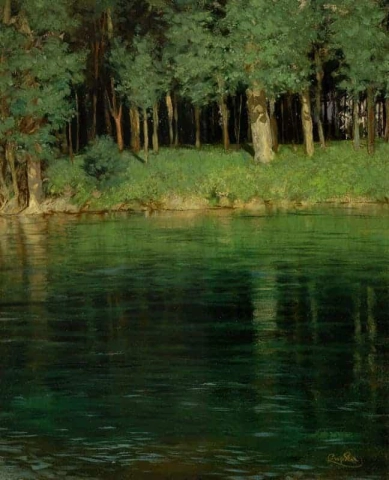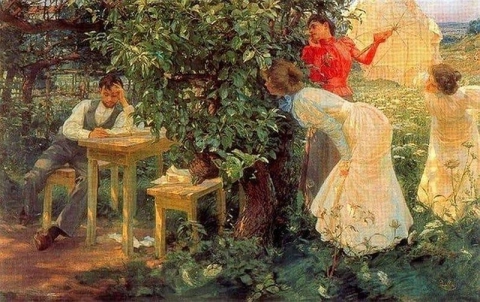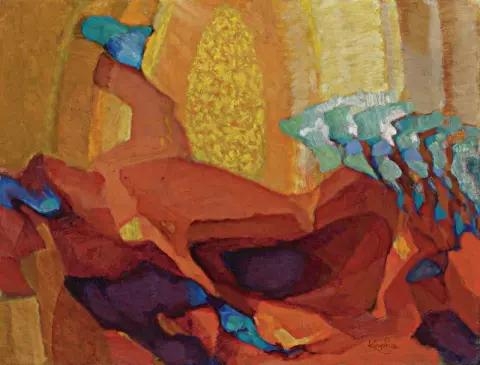

Hand painted reproductions of Frantisek Kupka
František Kupka: A Pioneer of Abstract Art and Color Theory
František Kupka (1871–1957) was a Czech painter and one of the founders of modern abstract art. Renowned for his innovative use of color and form, Kupka's work explored themes of movement, spirituality, and the interplay between music and visual art. His groundbreaking contributions positioned him as a key figure in the transition from representational art to abstraction.
Early Life and Education
Born on September 23, 1871, in Opočno, Bohemia (now part of the Czech Republic), František Kupka displayed an early talent for art and curiosity about the natural world. He initially trained as a saddle maker, but his artistic passion led him to study at the Academy of Fine Arts in Prague.
After completing his studies in Prague, Kupka moved to Vienna, where he enrolled at the Academy of Fine Arts. There, he explored symbolism and became fascinated with the relationship between art, philosophy, and spirituality. His time in Vienna profoundly influenced his future works, particularly his interest in esoteric ideas and theosophy.
Kupka later relocated to Paris in 1896, immersing himself in the city's vibrant artistic scene. In Paris, he further developed his artistic style, moving away from traditional academic art to embrace experimental and abstract forms.
Artistic Development and Style
Kupka’s early works were influenced by Symbolism and featured allegorical themes and mystical overtones. However, as his career progressed, he shifted toward abstraction, focusing on the dynamic interplay of color, form, and movement.
By the 1910s, Kupka had become a pioneer of pure abstraction, creating works that were entirely non-representational. His masterpiece, Amorpha: Fugue in Two Colors (1912), is considered one of the first purely abstract paintings in art history. Inspired by music, Kupka sought to translate rhythm and harmony into visual compositions, creating a synesthetic experience for viewers.
Kupka’s art was heavily influenced by his studies of color theory and scientific principles. He believed that colors and shapes had inherent emotional and symbolic properties, and his paintings often explored these relationships in intricate, layered compositions. His works, such as Disks of Newton and Warm Chromatics, exemplify his groundbreaking approach to color and movement.
Themes and Significance
Kupka’s art delved into themes of spirituality, the cosmos, and the connections between science and art. He was deeply influenced by the theosophical movement, which emphasized the spiritual dimensions of existence, and these ideas permeated his abstract compositions.
Music was another central theme in Kupka’s work. His fascination with the rhythm and harmony of musical compositions inspired him to experiment with visual equivalents, resulting in dynamic, flowing forms that seem to pulse with energy.
Kupka was also interested in the modern scientific discoveries of his time, including theories about light and motion. His art sought to depict these invisible forces, pushing the boundaries of visual expression and challenging traditional notions of representation.
Achievements and Influence
František Kupka’s contributions to abstract art were revolutionary. As an early proponent of non-representational painting, he paved the way for future movements such as Constructivism and Abstract Expressionism. His work was included in the landmark 1912 Salon d’Automne in Paris, where he exhibited alongside other avant-garde artists like Marcel Duchamp and Francis Picabia.
Kupka was a member of the Abstraction-Création group in the 1930s, which sought to promote abstract art across Europe. His influence extended beyond painting, as his theories on color and form continue to resonate with contemporary artists and art historians.
Legacy
František Kupka’s legacy as a pioneer of abstract art is firmly established. His innovative approach to color, movement, and spirituality redefined the possibilities of visual expression and inspired generations of artists to explore abstraction.
Today, Kupka’s works are housed in major museums, including the Centre Pompidou in Paris, the Museum of Modern Art in New York, and the National Gallery in Prague. His paintings remain celebrated for their visionary qualities and their ability to evoke emotion through pure form and color.
Where to Find Reproductions of František Kupka’s Art
For art enthusiasts who wish to bring the energy and spirituality of Kupka’s abstract works into their homes, high-quality reproductions are available. These reproductions capture the brilliance of his use of color and form, making his groundbreaking contributions accessible to modern audiences.
Imagine owning an original-style painting by one of the greatest artists in history. At POD, we offer you the chance to make this dream a reality. Each canvas is faithfully reproduced down to the smallest detail, allowing you to experience the beauty of the artist’s vision in your own home.
Our reproductions are crafted by experienced painters using the finest materials and time-honored methods. We are committed to delivering works of exceptional quality that will inspire and bring joy to your family for generations to come.





















